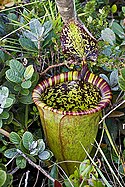Nepenthes attenboroughii
| ||
 | ||
| Systematyka[1][2] | ||
| Domena | eukarionty | |
| Królestwo | rośliny | |
| Podkrólestwo | rośliny zielone | |
| Nadgromada | rośliny telomowe | |
| Gromada | rośliny naczyniowe | |
| Podgromada | rośliny nasienne | |
| Nadklasa | okrytonasienne | |
| Klasa | Magnoliopsida | |
| Nadrząd | goździkopodobne | |
| Rząd | goździkowce | |
| Rodzina | dzbanecznikowate | |
| Rodzaj | dzbanecznik | |
| Gatunek | Nepenthes attenboroughii | |
| Nazwa systematyczna | ||
| Nepenthes attenboroughii Alastair Robinson, Stewart McPherson, Volker Heinrich Bot. J. Linn. Soc. 159(2): 196 (195-202; figs. 1-2, map). 2009= | ||
| Kategoria zagrożenia (CKGZ)[3] | ||
 | ||
Nepenthes attenboroughii – gatunek rośliny z rodziny dzbanecznikowatych. Został opisany w 2009 roku; nazwa gatunkowa honoruje Sir Davida Attenborougha. Charakterystyczną cechą tego gatunku są szczególnie duże liście pułapkowe, wyposażone w wąskie wieczko. Gatunek występuje w górskich obszarach Filipin. Pokrewnymi gatunkami są N. mantalingajanensis i N. mira z Palawanu, N. peltata z Mindanao i dzbanecznik radży (N. rajah) z Borneo.
Przypisy
- ↑ Michael A. Ruggiero i inni, A Higher Level Classification of All Living Organisms, „PLOS ONE”, 10 (4), 2015, e0119248, DOI: 10.1371/journal.pone.0119248, PMID: 25923521, PMCID: PMC4418965 [dostęp 2020-02-20] (ang.).
- ↑ Peter F. Stevens, Caryophyllales, [w:] Angiosperm Phylogeny Website [online], Missouri Botanical Garden, 2001– [dostęp 2009-10-07] (ang.).
- ↑ Nepenthes attenboroughii, [w:] The IUCN Red List of Threatened Species [online] (ang.).
Bibliografia
- Alastair S. Robinson i inni, A spectacular new species of Nepenthes L. (Nepenthaceae) pitcher plant from central Palawan, Philippines, „Botanical Journal of the Linnean Society”, 159 (2), 2009, s. 195–202, DOI: 10.1111/j.1095-8339.2008.00942.x, ISSN 0024-4074.
Media użyte na tej stronie
Autor: (of code) -xfi-, Licencja: CC BY-SA 3.0
The Wikispecies logo created by Zephram Stark based on a concept design by Jeremykemp.
Autor: Dr. Alastair Robinson, Licencja: CC BY 3.0
A lower pitcher of Nepenthes attenboroughii demonstrating the characteristic campanulate shape and upright lid of this species (Alastair Robinson, June 2007)


